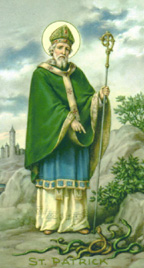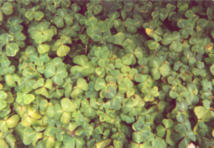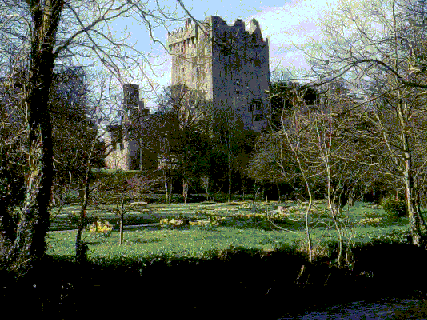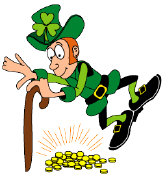


Why do so many Irish names begin with "O'?"
It reflects a practice found in many cultures:
the use of the
"patronymic."
Last names originated in the Middle Ages when men,
who embodied the continuity of the family, started to be
identified by their relationship to their immediate ancestors.
The son of David, for example, might take the name Davidson.
The Scots used "Mac," which meant "the son of," for this purpose.
And so with the Irish and the "O'," except here it meant "the
grandson of, " possibly because one of the first to use it,
Teigue, grandson of Brian, High-King of the Irish in the 11th
century, started to call himself Ua Briain (Gaelic for O'Brian)
after his famous grandfather.

ST. PATRICK
St. Patrick's Day is celebrated on March 17 to honor Patrick, Ireland's patron saint.
Almost 1500 years ago the patron saint and national hero of Ireland was born to a Gaelic family who had migrated to Britain.
For 16 years, Patrick lived a normal life as the son of a prosperous landowner and magistrate until he was captured and forced into slavery.
Patrick spent 6 years herding sheep.
He escaped and returned to Ireland to do missionary work.
History reports that he used shamrock leaves to explain the meaning of the Trinity.
It is also stated that he drove snakes from Ireland, banishing the venomous serpents by beating his drum. St. Patrick died on March 17, 493 after bringing the Christian faith to Ireland.
As the Irish emigrated around the world, they took the St. Pat's celebration with them.
The Irish heritage has had a profound influence on our nation.
The St. Patrick's Day custom came to America in 1737.
That was the first year St. Patrick's Day was publicly celebrated in this country, in Boston.

SHAMROCK
According to Irish legend, Ireland's patron saint chose the shamrock as a symbol of the Trinity of the Christian church.
To this day the shamrock remains the national emblem of Ireland and is worn proudly by Irish people the world over on St. Patrick's Day (March 17).
These plants are native to Europe and naturalized in North America.
The European wood sorrel (Oxalis acetosella), which grows in Europe and Asia, is also often considered to be the true shamrock.
Finding a four-leaf clover on Saint Patrick's Day is worth double the luck it normally is.
School children have started a little tradition of their own -- they pinch classmates who don't wear green on Saint Patrick's Day.

BLARNEY STONE
The Blarney Stone is a stone set in the wall of the Blarney Castle tower  in the Irish village of Blarney.
in the Irish village of Blarney.
Kissing the stone is supposed to bring the kisser the gift of persuasive eloquence (blarney).
The castle was built in 1446 by Cormac Laidhiv McCarthy (Lord of Muskerry) -- its walls are 18 feet thick
(necessary to thwart attacks by Cromwellians and William III's troops).
Thousands of tourists a year still visit the castle.
The origins of the Blarney Stone's magical properties aren't clear, but one legend says that an old woman cast a spell on the stone to reward a king who had saved her from drowning.
Kissing the stone while under the spell gave the king the ability to speak sweetly and convincingly.
It's tough to reach the stone -- it's between the main castle wall and the parapet.
Kissers have to lie on their back and bend backward (and downward), holding iron bars for support.
Can you imagine kissing something that has had people's lips all over it for 500 years? Ewwww!

THE CLADDAGH
The Claddagh is a visual portrayal of the eternal bond of friendship, loyalty,and love.
The HEART symbolizes love, life's finest impulse.
From it, generosity and compassions flow.
The HANDS of friendship are clasped around the heart in a gesture of giving.
As they cradle the heart gently, the hands are both protective and strong,like true friendship.
The CROWN is symbolic of loyalty.
It represents the reward of love, the hightest achievemnet the human spirit has yet accomplished.
To give the Claddagh is to forge the hands of love, friendship, and loyalty forever.

LEPRECHAUNS
Irish fairy. Looks like a small, old man (about 2 feet tall), often dressed like a shoemaker,with a cocked hat and a leather apron.
According to legend, leprechauns are aloof and unfriendly, live alone, and pass the time making shoes...they also possess a hidden pot of gold.
Treasure hunters can often track down a leprechaun by the sound of his shoemaker's hammer.
If caught, he can be forced (with the threat of bodily violence) to reveal the whereabouts of his treasure, but the captor must keep their eyes on him every second.
If the captor's eyes leave the leprechaun (and he often tricks them into looking away), he vanishes and all hopes of finding the treasure are lost.
The color green is associated with St. Patrick's Day because it is the color of spring, Ireland, and the shamrock.